#also my mom has repeatedly and very candidly refused to apologize for any of the above so this isn’t a case of
Text
.
#negativity cw#my parents’ anniversary is next week and they are not getting anything other than a 1 line ‘congrats’ in the whatsapp group chat#no gift no party no surprise trip no nothing#I’m the eldest child and now earning so I’m half certain they’ll side-eye me for not doing anything#idfc#it might seem petty and childish but after the Dec 2022 fights with my mom#where for two days in a row she screamed at me for hours#about how I was responsible for their marriage being on the rocks and verge of divorce#as well as a host of other fucked up things#on top of similar such threats/emotional blackmail every year since I was 13#I am never doing anything again to celebrate their Union#I still get them bday gifts and Father’s Day/Mother’s Day stuff#we still have a good relationship (ik it seems odd but despite everything we do)#but you don’t get to spend a decade blaming me for your adult inability to maintain your adult relationship#and expect me to celebrate it once I’m an adult#also my mom has repeatedly and very candidly refused to apologize for any of the above so this isn’t a case of#silently fuming and childishly refusing to communicate
3 notes
·
View notes
Note
Santi, kids, go.
for a second when i read this i didn’t remember the context of my own post and had a legitimate heart attack thinking ‘oh god is someone asking me something gross???’ and my heart rate jumped and my vision went blurry but then i remembered my post and also that i have one hell of an anxiety disorder so ghdkghdgk ANYWAY
WHO’S READY FOR SOME GOOD OL’ FASHIONED “K GOES ON A RANT ABOUT A MOVIE” LONG-FORM POSTING? BECAUSE THAT’S WHAT’S ABOUT TO HAPPEN HERE!
So, to make this legible, I’m going to, from here on out, use proper punctuation, capitalization, spelling, et cetera. I also should clarify that this post is largely only going to make sense if you’ve already seen Triple Frontier (now on Netflix!), so I suggest you go see that before you read this, if you’re interested in fully understanding what I’m talking about. I’ll include screenshots from the film for image reference, too, with specific points I’m talking about, but the weight of these scenes will work better if you’ve seen it actually in action. Oh, and this contains definite spoilers for the film, so if you wanted to watch it un-spoiled, better skip this post or watch the movie first and come back later.
Anyway, with all that preliminary stuff outta the way, let’s do a Classic K-Grade Deep Dive(TM).
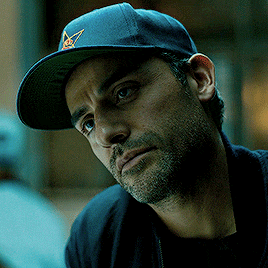
This is Santiago “Pope” Garcia. He’s the protagonist of the J.C. Chandor Netflix film, Triple Frontier. Santiago is an ex-Army soldier working in Colombia as part of a task force within the local government to find (and kill) the head of the largest drug cartel in the area, Gabriel Martin Lorea. His story and personality are the center of the film; he’s the first character we really meet in a longer, more personal sense, the first personality we get to know, the first empathy point and anchor for the audience. All the lives of other characters in the film are viewed through his lens, and he is the real heart and soul of the film.
As such, it’s an interesting note to see how often Santiago (whose name I’ll shorten here to Santi) is paired, on-screen and thematically, with children in the film. For example, within the first few minutes of the movie and his own introduction to the audience, he’s shown fist-bumping local children as he walks with armed officers to a selected point to begin a raid on a drug operation.

(This one’s a little hard to see, sorry!)
That decision is just so fascinating to me, especially when you think about the fact that every action shown on screen is an intentional choice. This is an intentional display: they, the filmmakers, want us to see Santi interacting with children. They want us to know he’s friendly with them, kind to them, empathetic to them. This empathy with and love for children that Santi has is frequently contrasted against his fellow teammates throughout the rest of the film, and is therefore, in my opinion, a clear directorial and acted choice to show us Santi’s true stances and heart, the core of his character: a loving, good man who cares for others, and very specifically for children and those he believes most need his protection and help.
Of course, this shows up later in the film in many different ways-- from Santi protecting Yovanna, his informant within Lorea’s group, and her brother, to Santi’s desire to free Colombia from corruption and help its people rise to greater, healthier heights-- but it remains the same idea: Santiago cares about people, and specifically those he feels need a little extra protection.
But what we’re specifically talking about here is how Santi is repeatedly shown interacting with or framed against children. So, on with the list of examples.
The next instance of Santi with children is when we see Santi interacting with Tom (”Redfly”)’s daughter, Tess. Tess greets him familiarly and by his first name, meaning that she not only knows him, but knows him well. Santi is shown smiling wide, his voice warm and loud as he greets her.
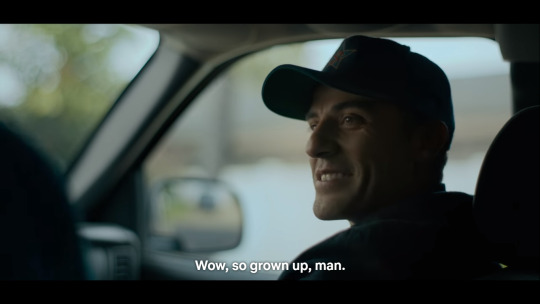
Immediately after this comment about Tess, we get a tracking shot of a young child at a sports meet (which appears to be baseball). The shot is framed to match Santi’s gazing out the window, meaning Santi is the one seeing this child.


I argue that the framing of this is nostalgic or longing, probably because I think part of Santi’s arc is about his longing to leave his life behind and move on to something better. I think, for Santi, part of that is family. Family is a major thematic element of the film, and I like to imagine that this scene and its framing is meant to put us in the mind of Santi as he wonders about what it would be like to be a father with a child at one of these sports events, what it would be like to have something normal like Tom has. Santi wants a family, and all the family he has in his life anymore are the men who comprised his team, before, which is why he reunites them for the action of the film. He wants a family. I sincerely believe that. He just doesn’t know how to find one that’s anything next to normal, yet.
At any rate, the next example follows shortly after the previous one, as Tom begins talking about the details of the case Santi is offering him. Santi turns over his shoulder to check the backseat where Tess is sitting, clearly uncomfortable with the idea of her overhearing something like this. I don’t think he’s worried about the potential security risk so much as he’s worried about the idea of a child hearing her father talk about something violent and scary.

Here’s the over the shoulder glance; I mean, that just reads “concerned father” to me, you know?
Anyway, the next scene immediately follows, with Santi talking candidly with Tess in the car while Tom is in the gas station. Tess asks him about if he’s trying to get Tom to work again, and Santi tries, at first, to be playful, hoping to relax her, but when she seems serious, he gets serious and kindly concerned, too.

He asks if she thinks her mom would still let Tom go, clearly trying to engage her and target what she’s concerned about. Hell, he’s even being empathetic to the idea that even though Tom and his wife are divorced, his ex-wife may still have a stake in and concern about Tom’s welfare. Santi clearly cares about Tom’s home life, and about the wellbeing of this child.
It’s interesting, too, because Santi appears to have more dialogue and time together with Tess than even her father does, in terms of on-screen time. Again, the film is showing us Santi and children for a reason: he listens, he cares, he sees them.

This one’s blurry but I just thought I’d include the fact that Santi specifically says goodbye to Tess when he could easily have ignored her and just hopped out. He’s a sweetie.
The next scene doesn’t happen for a while, but when the team crashes their helicopter into the fields of a remote village, Santi is instantly hesitant to draw his weapon on the crowd that gathers around them. He does not fire, even when the situation grows more tense; his other teammates are the ones to open fire. In the crowd we can see a young, teenaged boy (who later returns to get revenge on Tom, who initiated the firing on the crowd), and a very young girl, who manages to survive.
Santi is the one shown speaking to the village leader. Santi is the one who takes the initiative to go to that man and give him several million dollars in damages and express his sorrow for this loss. He specifically asks that the money be given to the families of those who were killed. Specifically. Again, Santi is not only shown to be empathetic to the lives of others, but specifically to the children, too.
Interestingly, in the scene where the camera sits in the viewpoint of Tom as he walks to where Santi is (as Santi is talking with and giving the money to the leader of the village), it is specified in the audio description that a baby is crying.

Again, a framing of Santiago and children. It’s a little loose, but I feel like there’s intentionality in that; there had to be a decision to lay that audio in, a decision to incorporate the sounds of an anxious child with Santi’s attempts to fix the problem.
Later, when this teenaged boy from the village tracks the team to get revenge on Tom, who opened fire, it’s noted that Santi is not the one being shot at. Tom is. Again, this reinforces to the audience that Santi is not only not the villain, but someone who even children who don’t know him will respect and understand will not hurt them.
After Tom is killed by this same boy, Santi goes through an intense bout of rage as Benny reports that Lorea’s men have gathered a child army to try and capture the team. For a moment, Santi snaps and yells that they’ll “go through them”, suggesting that they kill whoever stands in their way to bring Tom’s body home, but he quickly shuts himself down and turns away, immediately becoming apologetic and rescinding his comment, knowing full well that he didn’t mean it. It later becomes clear that he was entirely sincere in this apology, because when they encounter the child soldiers, Santi refuses to do them any harm, and, in fact, helps the first one they meet, and refuses to allow his teammates to shoot them or hurt them.
The first child soldier they meet is a young boy, and whereas his teammates draw guns on the young boy, Santi is quick to yell at everyone to calm down and holsters his own weapon, putting his hands out in a show of defense.
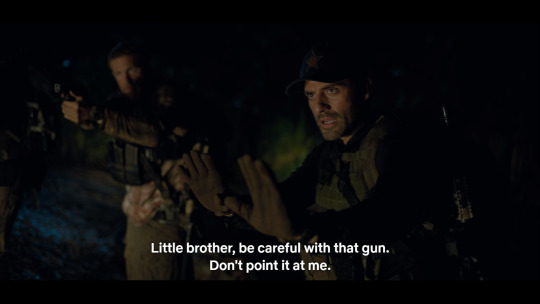
He speaks to the boy in Spanish, showing that he is colloquial and personable with the boy. He’s trying to relate to him, calm him.
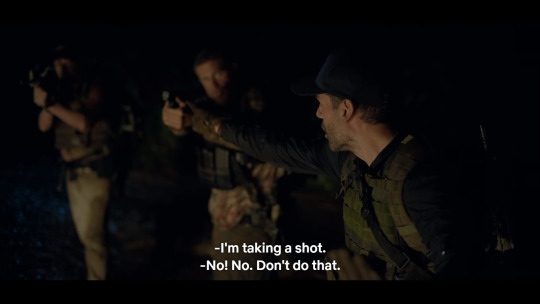
When Fish suggests he’s going to shoot, Santi raises his voice in a clear, anxious yell to tell him not to. He’s trying, desperately, to protect this boy.
The boy then calls for backup, and the team ties him up to steal his car. However, Santi lags behind to give the boy a stack of hundred dollar bills:

And advice:

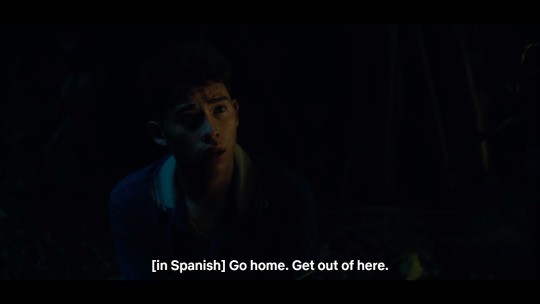
And then cuts his ties loose and lets him go. He is STILL trying to protect this boy! Even after, when Fish yells at Santi for giving the kid money and berates him for not killing the boy, Santi yells back that they are not to kill anyone.
Next, the backup that the boy called for arrives, and, lo and behold, it’s also all teens and children. Santi is perched in the back of the truck with a perfect vantage point to shoot and kill all of them in the car that has chased them, but he pauses, clearly unwilling, and then, instead, fires warning shots at their engine, incapacitating the car but not hurting a single soul inside.
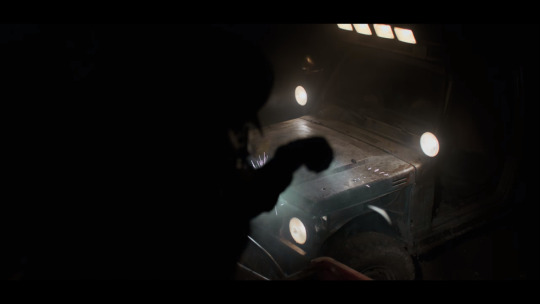
There are several back and forth shots between Santi’s face and the teens (too many for me to cap, frankly), and these serve to once again reinforce to us, the audience, just how deep Santi’s empathy runs.
More cars follow, and Fish yells at Santi to “shoot the driver”:

But Santi won’t do it. Again, he only damages the cars, shooting out their tires. Again and again, throughout the scene, Fish yells at Santi to kill these kids, even as Santi blows out tires and new cars show up.

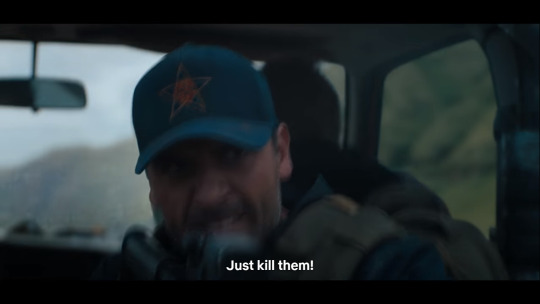
But he won’t.
Once again, Santi aims for the tires. And he succeeds in only damaging the car, not the passengers.
Finally, as the film closes, Santi’s parting words with the last teammate he says goodbye to, William, are about Tom’s family, and specifically his daughters.

Again, he’s worried about the children. He always is. Santi’s concern for children is such a major part of his character presence, it’s almost impossible to miss!
So.
Why would I make this excruciatingly long post that required me to minute-by-minute revisit the movie and look for individual frames to show Santi interacting with or thinking about kids? Well, here are some reasons.
1. It’s always important to recognize recurrent themes, images, motifs, et cetera in films, and especially how they tie with characters. These choices are often intentional and left there by the artists making the film so that audiences, whether cognizant or subconsciously, can pick up on this information and see how it reflects on the character. Here, we learn that Santi is good with, friendly to, empathetic with, and protective of children. That shows us a good, heroic man, and someone the audience is meant to support, even when the chips are down. From an analytical standpoint, it’s good to be aware of this so you can better dissect and understand what a story is trying to tell you.
2. You all know I’m a softie who cares a lot about kids and I want the male characters I love or form affinities with to have similar attributes. This is a nice, big reference post for me to validate my stance on believing that Santi not only loves kids, but would be great working with them and being a father in his own right. Because I’m a sap.
3. I think it’s important to find examples of compassionate, caring male characters, especially men of color. I’ve seen a lot of disparaging comments made about Santi in the Triple Frontier tag, usually in order to bolster the image of his white teammates. And I wanted this to be a kind of definitive masterpost, if only for myself, about the fact that Santi is not only a good man, but oftentimes the better man out of all of them. So could y’all stop being racist against the POC characters in this film, please, could y’all sTOP-
4. Narratively, it gives us a better insight into what this movie is actually about. Because, quite frankly? It’s not a heist movie. I don’t think it was ever intended to be. A heist movie is something like Ocean’s Eleven, where the heist itself is almost a character. In this, the heist is background noise to the story that’s really being told; this movie is a story about people, and specifically one man, looking to make their lives better, and a story about families, bonds, personal connections. Now, I agree, the movie had some issues, absolutely, but I think that looking at this story as being Santi’s search for connections, for a family, really sheds light on how a lot of this movie works, and why it is the way that it is. By looking at his relationship with children and his personal arc with that, we’re informed about what he values, and the importance that he places on other lives. The movie turns from a “kickass action heist” into a more contemplative, thoughtful film about the cost of violence and selfishness, the loss we experience when we think only of ourselves, the real value of life and connection and love, in all its many forms. Familial, protective bonds are at the forefront of the piece, and recognizing that makes this movie make a whole lot more sense.
5. Men who are good with kids are hot. Which is also the point I made in 2., but it’s my post and I get to say what I want, goddamnit!
Anyway. I could go on for hours about ways we could interpret this or how it’s a valuable asset of the film, but I want to leave it up to every person to make their own decisions about it. I just wanted to be the one to point it out, since I think it’s a heavily glossed-over part of the story, and a very ignored part of Santi’s character and his story arc.
Also, let Santi be a dad 2kforever. Just sayin’.
That about concludes this post! If anyone wants to hear more about it or probe on the topic some more, I have lots more thoughts and opinions to share. Even if the movie is a little, shall we say, rocky in places, Santi and his story still hold a huge place in my heart, and I think a lot of this movie is actually really well done. J.C. Chandor really let Oscar shine, and I’m very moved by the work he, specifically, did in the film. Yay, Santi!
#long post#triple frontier#santiago garcia#i am incredibly valid and yes i am posting this at 2 am but god gave me a mission#gif warning#guns /#violence /#death mention /#lmk if this needs any other tags#drugs mention /#Anonymous
21 notes
·
View notes